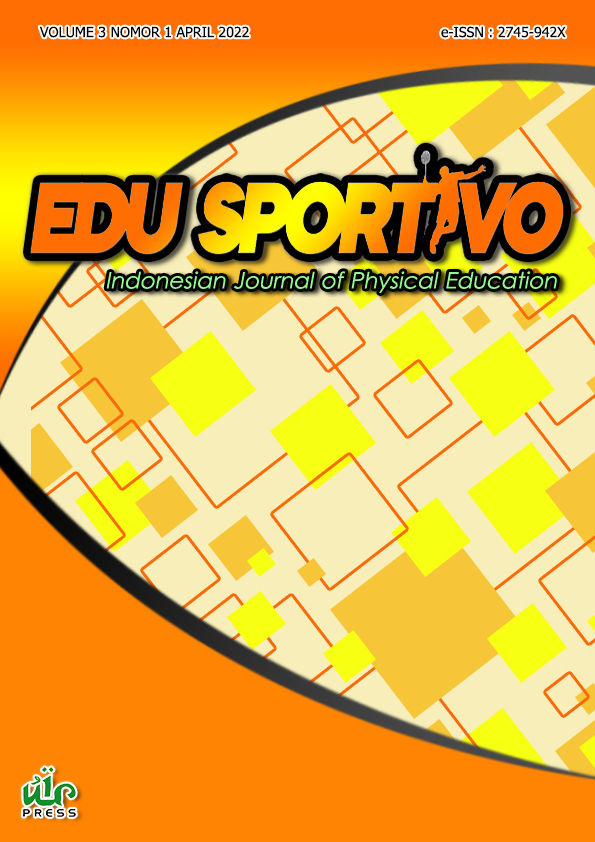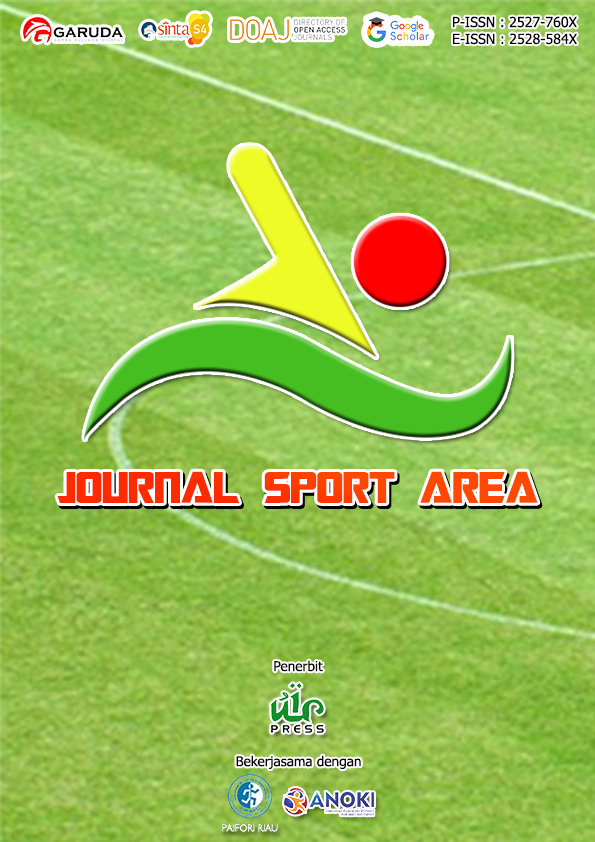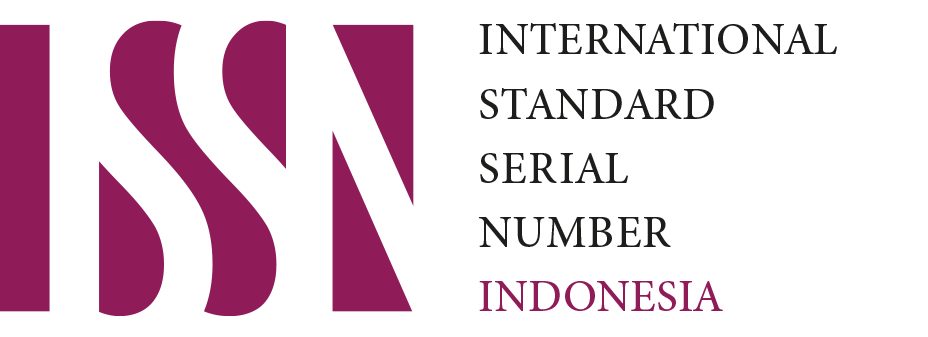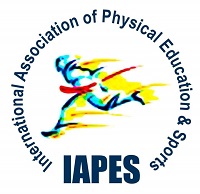Efektivitas metode pembelajaran daring terhadap hasil belajar kognitif materi bolavoli
Keywords:
Online learning, cognitive learning outcomes, volleyball, covid-19Abstract
Volleyball learning materials are transitioning from face-to-face learning to online learning. The purpose of this study was to find out how the implementation of online learning of volleyball material at MAN 1 Tegal and to find out how much effectiveness online learning had on cognitive learning outcomes. The type of data used is mixed methods research. The sample used is class X students at MAN 1 Tegal. At the quantitative stage of data collection using recap documentation, data analysis using the mean value. At the qualitative stage of data collection using interviews, data analysis using data reduction. Recapitulation of cognitive aspects of volleyball material obtained results of 100% of all respondents passing volleyball material with an average value of 73.31. The conclusion of this study is that the implementation of online learning for class X volleyball in MAN uses the emergency curriculum 13, there are many obstacles that hinder online learning, recap of the cognitive scores of 100% of all respondents passing the volleyball material with an average value of 73.31. Based on the results of this study, it can be seen that all deficiencies in the learning process during the COVID-19 pandemic are expected to be corrected, so that learning media can be found that are suitable for use in physical education learning.
Downloads
References
Abdullah, H., Malago, J. D., & Arafah, K. (2021). The implementation of physics learning through online mode during pandemic covid-19 using metacognitive knowledge-based materials. Jurnal Pendidikan IPA Indonesia, 10(2), 220–227. https://doi.org/10.15294/jpii.v10i2.28583
Anggara, F. (2021). Evaluasi tingkat pembelajaran pendidikan pandemi covid-19. Jurnal Ilmiah Bina Edukasi, 1(1), 37–45. https://doi.org/10.54371/jiip.v4i3.236
Anjelin, A. E., & Purnomo, H. (2021). Efektivitas pembelajaran daring siswa sekolah dasar di masa pandemi. JIIP - Jurnal Ilmiah Ilmu Pendidikan, 4(3), 159–163. https://doi.org/10.54371/jiip.v4i3.236
Basar, A. M. (2021). Problematika pembelajaran jarak jauh pada masa pandemi covid-19. Edunesia : Jurnal Ilmiah Pendidikan, 2(1), 208–218. https://doi.org/10.51276/edu.v2i1.112
Burhaein, E., Tarigan, B., Budiana, D., Hendrayana, Y., & Phytanza, D. T. P. (2021). Physical Activity level of students with disabilities during covid-19 pandemic. Jurnal Pendidikan Jasmani dan Olahraga, 6(2), 236–242. https://doi.org/10.17509/jpjo.v6i2.38547
Duciano, J., Mateo, W., Junior, R. J., Verzosa, J. I., & Tinowen, D. J. (2021). Students’ experiences in learning physical education in an online environment. Edu Sportivo: Indonesian Journal of Physical Education, 2(3), 140–154. https://doi.org/10.25299/es:ijope.2021.vol2(3).7792
Fadhilah, A. R., Fitri, R. R., & Wibowo, Y. S. (2021). Distance education di masa covid-19: tinjauan terhadap sistem, kebijakan, dan tantangan e-education di sekolah. Jurnal Akuntabilitas Manajemen Pendidikan, 9(2), 171–188. https://doi.org/10.21831/jamp.v9i2.42648
Hudah, M., Widiyatmoko, F. A., Pradipta, G. D., & Maliki, O. (2020). Analisis pembelajaran pendidikan jasmani di masa pandemi covid-19 di tinjau dari penggunaan media aplikasi pembelajaran dan usia guru. Jurnal Porkes, 3(2), 93–102. https://doi.org/10.29408/porkes.v3i2.2904
Ismail, A. (2019). Penerapan model pembelajaran berbasis masalah untuk meningkatkan hasil belajar fisika siswa pada pokok bahasan listrik. Gema Wiralodra, 8(2), 167–181. https://doi.org/10.31943/gemawiralodra.v8i2.92
Isman, M., & Hanafi, M. (2016). Pembelajaran Moda Dalam Jaringan (Moda Daring). The Progressive and Fun Education Seminar, 1, 548–555.
Kartika, D., Amril, O., Mardius, A., Prajana, A., Astuti, Y., & Zulbahri, Z. (2020). Pendampingan mahasiswa terhadap metamorfosis pembelajaran di masa pandemi covid 19. J-ABDIPAMAS (Jurnal Pengabdian Kepada Masyarakat), 4(2), 1–8.
Lucero, R. (2021). Effects of instructional materials in multimedia computer-assisted instruction in teaching folk dance. Edu Sportivo: Indonesian Journal of Physical Education, 2(1), 40–50.
Lukitowati, S., & Triansyah, A. (2021). Strategi komunikasi berbasis multimedia dalam pendidikan jarak jauh pada mata kuliah atletik. Gelanggang Olahraga: Jurnal Pendidikan Jasmani dan Olahraga, 4(2), 162–173. https://doi.org/10.31539/jpjo.v4i2.2124
Maftuhin, R. A., Pati, P. K., & Setyawan, D. A. (2021). Efektifitas guru pendidikan jasmani dalam pembelajaran daring. Edu Sportivo, 1(1), 106–111. https://doi.org/10.25299/es:ijope.2021.vol2(2).7007
Moleong, L. J. (2016). Metodologi Penelitian Kualitatif Edisi Revisi. PT. Remaja Rosdakarya.
Muhyi, A. A., Septiadi, F., & Maulana, F. (2021). Respons mahasiswa pendidikan jasmani kesehatan dan rekreasi terhadap pembelajaran daring saat pandemi covid-19. Journal of Education and Sport Science, 2(1), 9–14.
Nopiyanto, Y. E., & Raibowo, S. (2020). Penerapan model pembelajaran Jigsaw untuk meningkatkan motivasi dan hasil belajar mahasiswa penjas pada mata kuliah filsafat penjas dan olahraga. Journal of Sport Education (JOPE), 2(2), 61. https://doi.org/10.31258/jope.2.2.61-69
Novita, A., & Andriani, A. (2019). Prototipe E-learning untuk pendalaman dan evaluasi materi pembelajaran pada SMPN 1 Samigaluh. JITK (Jurnal Ilmu Pengetahuan Dan Teknologi Komputer), 4(2), 211–216.
Ntelok, R., Nantung, Y. D. S., & Tapung, M. M. (2021). Peran orang tua dalam mendampingi anak belajar selama masa belajar dari rumah. Jurnal Literasi Pendidikan Dasar (JLPD), 2(2), 6–13.
Nuriansyah, F. (2020). Efektifitas penggunaan media online dalam meningkatkan hasil belajar siswa di masa. Jurnal Pendidikan Ekonomi Indonesia, 1(2), 61–65.
Pratama, R. E., & Mulyati, S. (2020). Pembelajaran Daring dan Luring pada Masa Pandemi Covid-19. Gagasan Pendidikan Indonesia, 1(2), 49–59.
Puspitasari, M. A., Herlambang, T., & Kusumawardhana, B. (2021). Analisis pembelajaran penjasorkes melalui media daring terhadap hasil belajar kognitif passing atas siswa kelas XI SMA Negeri 3 Pati. Journal of Physical Activity and Sports (JPAS), 2(3), 288–296. https://doi.org/10.53869/jpas.v2i3.99
Renshaw, I., Chow, J. Y., Davids, K., & Hammond, J. (2010). A constraints-led perspective to understanding skill acquisition and game play: a basis for integration of motor learning theory and physical education praxis? Physical Education and Sport Pedagogy, 15(2), 117–137.
Rifaldi, & Gazali, N. (2020). Pandemi Covid-19: Bagaimana motivasi siswa pada pembelajaran pendidikan jasmani dalam menggunakan e-learning? Edu Sportivo: Indonesian Journal of Physical Education, 2(1), 33–39. https://doi.org/10.25299/es:ijope.2021.vol2(1).6025
Rohmawati, A. (2015). Efektivitas pembelajaran. Jurnal Pendidikan Usia Dini, 9(1), 15–32.
Rustiadi, T. (2018). Acceleration number of head lectors through the intervention of the model of paper sosio transformis. Journal of Physical Education Health and Sport, 5(1), 1–5.
Setiyawan, Kresnapati, P., & Aji Setyawan, D. (2020). Analisis perkuliahan daring mahasiswa PJKR Universitas PGRI Semarang sebagai dampak pandemi covid 19. Edu Sportivo: Indonesian Journal of Physical Education, 1(1), 25–32. https://doi.org/10.25299/es:ijope.2020.vol1(1).5148
Setyosari, P. (2017). Menciptakan Pembelajaran yang efektif dan berkualitas. JINOTEP (Jurnal Inovasi Dan Teknologi Pembelajaran) Kajian Dan Riset Dalam Teknologi Pembelajaran, 1(1), 20–30. https://doi.org/10.17977/um031v1i12014p020
Simamora, R. M. (2020). The Challenges of online learning during the COVID-19 pandemic: An essay analysis of performing arts education students. Studies in Learning and Teaching, 1(2), 86–103.
Sofyana, L., & Rozaq, A. (2019). Pembelajaran daring kombinasi berbasis whatsapp pada kelas karyawan Prodi Teknik Informatika Universitas PGRI Madiun. Jurnal Nasional Pendidikan Teknik Informatika (JANAPATI), 8(1), 81. https://doi.org/10.23887/janapati.v8i1.17204
Supriyandi, A., & Dupri. (2020). Peningkatan hasil belajar bolavoli dengan menggunakan sistem daring. Edu Sportivo: Indonesian Journal of Physical Education, 1(2), 112–119. https://doi.org/10.25299/es:ijope.2020.vol1(2).5609
Vinet, L., & Zhedanov, A. (2011). A “missing” family of classical orthogonal polynomials. Journal of Physics A: Mathematical and Theoretical, 44(8), 139–148. https://doi.org/10.1088/1751-8113/44/8/085201
Wardani, D. N., Toenlioe, A. J. E., & Wedi, A. (2018). Daya tarik pembelajaran di era 21 dengan blended learning. Jurnal Kajian Teknologi Pendidikan (JKTP), 1(1), 13–18.
Yuangga, K. D., & Sunarsi, D. (2020). Pengembangan media dan strategi pembelajaran untuk mengatasi permasalahan pembelajaran jarak jauh di pandemi covid-19. JGK (Jurnal Guru Kita), 4(3), 51–58.
Zheng, W., Ma, Y. Y., & Lin, H. L. (2021). Research on blended learning in physical education during the covid-19 pandemic: A case study of chinese students. SAGE Open, 11(4). https://doi.org/10.1177/21582440211058196
Published
How to Cite
Issue
Section
This is an open-access article distributed under the terms of the Creative Commons Attribution-ShareAlike 4.0 International License which permits unrestricted use, distribution, and reproduction in any medium. Users are allowed to read, download, copy, distribute, search, or link to full-text articles in this journal without asking by giving appropriate credit, provide a link to the license, and indicate if changes were made. All of the remix, transform, or build upon the material must distribute the contributions under the same license as the original.
Accepted 2022-02-28
Published 2022-03-22



.png)




















.png)







.png)





